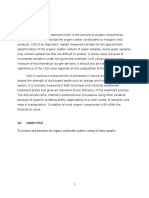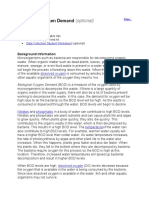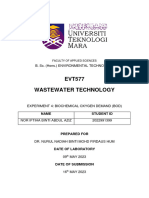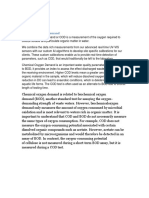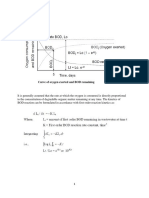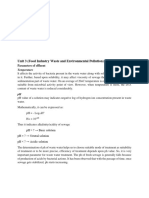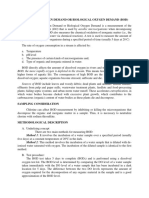Bod Exp WWT
Bod Exp WWT
Uploaded by
Asyraf BangsCopyright:
Available Formats
Bod Exp WWT
Bod Exp WWT
Uploaded by
Asyraf BangsOriginal Description:
Original Title
Copyright
Available Formats
Share this document
Did you find this document useful?
Is this content inappropriate?
Copyright:
Available Formats
Bod Exp WWT
Bod Exp WWT
Uploaded by
Asyraf BangsCopyright:
Available Formats
1.0 OBJECTIVES To determine the amount biological oxygen demand, BOD in water sample.
e. The objective of this experiment is to determine the Biochemical Oxygen Demand (BOD) for sample from Taman Jati by calculating the Dissolved Oxygen (DO) of the sample.
2.0 SUMMARY Biochemical oxygen demand or B.O.D. is the amount of dissolved oxygen needed by aerobic biological organisms in a body of water to break down organic material present in a given water sample at certain temperature over a specific time period. The term also refers to a chemical procedure for determining this amount. This is not a precise quantitative test, although it is widely used as an indication of the organic quality of water.[1] The BOD value is most commonly expressed in milligrams of oxygen consumed per litter of sample during 5 days of incubation at 20 C and is often used as a robust surrogate of the degree of organic pollution of water. The purpose of this experiment is to determine the amount biological oxygen demand, BOD in water sample. From the experiment and result we can know the tertiary treatment is the suitable treatment. It is because the tertiary treatment used the low amout of BOD.
3.0 INTRODUCTION & THEORY Biochemical oxygen demand or B.O.D. is the amount of dissolved oxygen needed by aerobic biological organisms in a body of water to break down organic material present in a given water sample at certain temperature over a specific time period. The term also refers to a chemical procedure for determining this amount. This is not a precise quantitative test, although it is widely used as an indication of the organic quality of water. The BOD value is most commonly expressed in milligrams of oxygen consumed per liter of sample during 5 days of incubation at 20 C and is often used as a robust surrogate of the degree of organic pollution of water. BOD can be used as a gauge of the effectiveness of wastewater treatment plants.
The BOD5 test Dilution method To ensure that all other conditions are equal a very small amount of microorganism seed is added to each sample being tested. This seed is typically generated by diluting organisms with buffered dilution water. The BOD test is carried out by diluting the sample with oxygen saturated dilution water, inoculating it with a fixed aliquot of seed, measuring the dissolved oxygen (DO) and then sealing the sample to prevent further oxygen dissolving in. The sample is kept at 20 C in the dark to prevent photosynthesis (and thereby the addition of oxygen) for five days, and the dissolved oxygen is measured again. The difference between the final DO and initial DO is the BOD.
The loss of dissolved oxygen in the sample, once corrections have been made for the degree of dilution, is called the BOD5. For measurement of carbonaceous BOD (cBOD), a nitrification inhibitor is added after the dilution water has been added to the sample. The inhibitor hinders the oxidation of ammonia nitrogen. BOD can be calculated by: Undiluted: Initial DO - Final DO = BOD Diluted: ((Initial DO - Final DO)- BOD of Seed) x Dilution Factor
BOD is similar in function to chemical oxygen demand (COD), in that both measure the amount of organic compounds in water. However, COD is less specific, since it measures everything that can be chemically oxidized, rather than just levels of biologically active organic matter.
4.0 RESULTS AND DISCUSSIONS RESULT Raw sewage Volume (mL) 2 5 10 Secondary treatment Volume (mL) 20 50 100 Tertiary treatment Volume (mL) 100 300 Formula BOD = (DOI DOF)n
Initial DO, (mg/L) 92.4 91.3 92.0
DOI Final DO, (mg/L) 7.90 6.43 6.72
DOF BOD5 (mg/L) 12675 5092.2 2558.4
Initial DO, (mg/L) 87.1 79.6 68.3
DOI Final DO, (mg/L) 3.32 0.03 0.04
DOF BOD5 (mg/L) 1256.7 477.42 204.78
Initial DO, (mg/L) 71.7 28.2
DOI Final DO, (mg/L) 0.04 0.02
DOF BOD5 (mg/L) 214.98 28.18
DISCUSSION BOD measurement requires taking the sample at the site. First it is tested immediately for dissolved oxygen, and then put in the incubator at 20oC for 5 days and then tested for the amount of dissolved oxygen remaining. The difference in oxygen levels between the first reading and the second reading multiply with dilution factor, in milligrams per liter (mg/L), is the amount of BOD. DO refers to the volume of oxygen that is contained in water while BOD is the amount of dissolved oxygen which is used up by the microorganisms and is roughly equivalent to the amount of organic matter found in the wastewater. The more organic matter that is present in the water, the more DO will be used up by the bacteria and the greater the BOD reading will be. This also represents the amount of oxygen consumed by microorganisms to break down the organic matter present in the sample bottle during the period. The greater the BOD, the more rapidly oxygen is depleted in the stream. This means less oxygen is available to higher forms of aquatic life. The consequences of high BOD are the same as those for low dissolved oxygen.
From the experiment, the BOD of the raw sewage has a higher value compared to the secondary treatment and tertiary treatment. This shows that there are many bacteria in the raw sewage that used up the oxygen. For the tertiary treatment, the reading of BOD is at the lowest. It shows that it is less used up of oxygen compared to raw sewage. A low BOD is an indicator of good quality water, while a high BOD indicates polluted water. In this experiment, the final reading of BOD was taken at the 5 days. This is because there are two stages of decomposition in the BOD test, a carbonaceous stage and a nitrogenous stage. The carbonaceous stage, or first stage, represents that portion of oxygen demand involved in the conversion of organic carbon to carbon dioxide. The nitrogenous stage, or second stage, represents a combined carbonaceous plus nitrogenous demand, when organic nitrogen, ammonia, and nitrite are converted to nitrate. Nitrogenous oxygen demand generally begins after about 6 days.
5.0 CONCLUSION AND RECOMMENDATIONS From the experiment, we can conclude that the tertiary treatment is the best treatment among the raw sewage and secondary treatment. It is because the tertiary treatment used up the less oxygen compare to raw sewage and secondary treatment. In addition, the lower BOD will be produced a good quality of water rather than the higher BOD will be produced very poor quality water. For a better result in future, the point should be noted is make sure there is no bubble when pouring the sample in bod bottle. It is because there possible high in value is got bubble inside the bottle.
6.0 TUTORIAL 1. Why is the BOD the most important measurement is wastewater? Biochemical Oxygen Demand, BOD, as it is commonly abbreviated, is one of the most important and useful parameters indicating the organic strength of a wastewater. BOD measurement permits an estimate of the waste strength in terms of the amount of dissolved oxygen required to break down the wastewater. It is essentially a measure of the biological and the chemical component of the waste in terms of the dissolved oxygen needed by the natural aerobic biological systems in the wastewater to break down the waste under defined conditions. 2. How can a single parameter, BOD, quantify the entire gamut of the pollution aspects of wastewater ? The same parameter, BOD, is then used to measure the strength of sewage and the efficiency of wastewater treatment plants. High concentrations of organic matter could result in almost complete depletion of oxygen in the soil-water matrix. If this were to happen aerobic microbes would begin to die off, and if this wastewater were discharged to a stream, local ecology could be severely damaged. High levels of BOD in streams cause the dissolved oxygen (DO) content of the water to drop. It is this DO that fish, and zooplankton use to survive. If the DO drops to below a critical level the ecology of the stream could begin to die off as well. This condition can lead to an increase in anaerobic bacteria (species that can live in the absence of oxygen) that leads to the production of foul-smelling and possibly toxic gases. These gases may include methane, hydrogen sulfide, and ammonia. If this water were to enter into groundwater sources one can imagine the potential problems with toxicity to humans. This is why BOD is important to determine DO, to ensure it remain in safe range. Wastewater treatment plant would make use of BOD monitoring to ensure that DO levels in the system and receiving streams remain in a safe range. This would be done by measuring BOD of all applied wastewater, and the final effluent. In some cases BOD would be tested at certain points in the soil system by collecting water from monitoring wells. This would be done to make sure DO levels are not falling to a critical level thus harming bacteria within the treatment system.
3. List down two potential error during the taking of the sample that could affect the reading of the sample data. a) Equipment like conical flask, or glass container to take the sample already containminated with bacteria or microorganism. b) Wrong sampling procedure. c) Error in labelling the equipment after taking the sample. d) Lack of control sample. e) Sample taken is too little 4. Define Standard A and Standard B in wastewater. In 1985, The Department of Environment (DOE) have introduce the Receiving Water Quality criteria for Malaysia in 1985 which aimed at developing a water quality management approach for the long term water quality of the nation's water resources. The Environment Quality (Sewerage and Industrial Effluents) Regulations 1979 set out two standards of effluent quality, Standard A and B. Effluent that is discharged upstream of a water supply intake should meet Standard A, while effluent that is discharged downstream has to meet Standard B. Effluent from sewage treatment plants need to be sampled at regular intervals and tested to ensure that it meets the required standards. Monitoring of the water quality was done, to ensure the efficiency of the treatment processes 5. Two effects of BOD in the water (river, lake & etc). Biochemical oxygen demand is a measure of the quantity of oxygen used by microorganisms in the oxidation of organic matter. Natural sources of organic matter include plant decay and leaf fall. Urban runoff carries pet wastes from streets and sidewalks; nutrients from lawn fertilizers; leaves, grass clippings, and paper from residential areas, which increase oxygen demand. Oxygen consumed in the decomposition process robs other aquatic organisms of the oxygen they need to live causing the depletion of oxygen in the water. Consumers like fish and other aquatic animals eat some of the producers, and the nutrients move up the food chain. When these organisms die, bacteria decompose the organic compounds and release into the water inorganic nutrients such as nitrate, phosphate, calcium, and others. Some of these nutrients end up downstream or in sediments, but most of them recycle again and again. Most of the bacteria in the aquatic water column are aerobic. That means that they use oxygen to perform their metabolic activities of decomposition. Natural
levels of oxygen in aquatic systems are always somewhat depleted by normal levels of aerobic bacterial activity. In most cases, if dissolved oxygen concentrations drop below 5 parts per million, fish will be unable to live for very long. When abnormally high levels of aerobic bacterial activity takes place, the level of dissolved oxygen can drop dramatically. Generally, this occurs when there is some sort of abnormal pollution introduced into the system. This can occur in the form of organic pollution for sources such as domestic sewage, septic tank leakage, and fertilizer runoff, or could be in the form of inorganic from domestic or industrial sources. Natural sources of organic compounds can also come into aquatic systems by means of floods, landslides, and erosion.
7.0 REFERENCES
D. Barnes, P. J. Bliss, B. W. Gould, H. R. Valentine (1981). Water and Wastewater Engineering Systems. Pitman Masters G. M. (1991). Introduction to Environmental Engineering and Science. Prentice Hall. New Jersey. Eckenfelder, Jr. W. W. (1980). Principles of Water Quality
Management.CBIPublishing Company, Inc. USA Lenore S. Clescerl, Arnold E. Greenberg, Andrew D. Eaton (1999). Standard Methods for Examination of Water & Wastewater (20th ed.). Washington, DC: American Public Health Association.
You might also like
- COD Lab ReportDocument13 pagesCOD Lab ReportAmirulizwan Azamri85% (13)
- Report BODDocument16 pagesReport BODMuhammad Aimi100% (1)
- Bod, Cod PDFDocument2 pagesBod, Cod PDFRiyan SyedNo ratings yet
- Biogas Plant: Biogas Digester Design, Gas Production and PurificationFrom EverandBiogas Plant: Biogas Digester Design, Gas Production and PurificationNo ratings yet
- Biological Oxygen DemandDocument7 pagesBiological Oxygen DemandRahul RajNo ratings yet
- Faculty of Applied Sciences BodDocument5 pagesFaculty of Applied Sciences BodnrbtrsyialiaNo ratings yet
- Biochemical Oxygen DemandDocument12 pagesBiochemical Oxygen DemandChandra SekaranNo ratings yet
- Biochemical Oxygen Demand or BODDocument8 pagesBiochemical Oxygen Demand or BODlasiantheraNo ratings yet
- OxygenDocument18 pagesOxygenNafees KhanzadaNo ratings yet
- Biochemical Oxygen DemandDocument2 pagesBiochemical Oxygen DemandMuhdPedotFirdausNo ratings yet
- Wastewater Quality IndicatorsDocument7 pagesWastewater Quality IndicatorsFarida HartatiNo ratings yet
- Introduction To Biochemical Oxygen DemandDocument22 pagesIntroduction To Biochemical Oxygen Demandlollol91No ratings yet
- Nor Iftiha Binti Abdul Aziz (2022991399) - Lab Report BodDocument6 pagesNor Iftiha Binti Abdul Aziz (2022991399) - Lab Report BodNor Iftiha AzizNo ratings yet
- BOD and CODDocument7 pagesBOD and CODShannen SiyNo ratings yet
- Lab 4 BODtestDocument7 pagesLab 4 BODtestcindyn_46100% (2)
- EVT577 Wastewater Exp3 BODDocument6 pagesEVT577 Wastewater Exp3 BODFadzrilNo ratings yet
- Biological Oxygen DemandDocument4 pagesBiological Oxygen DemandIkhlasOasis JohorNo ratings yet
- The University of Zambia School of Natural Sciences Department of Biological Sciences BIO-4321Document4 pagesThe University of Zambia School of Natural Sciences Department of Biological Sciences BIO-4321Lucy ZuluNo ratings yet
- Cod & Do-BodDocument19 pagesCod & Do-BodBishal BhariNo ratings yet
- DBO IntroducciónDocument22 pagesDBO IntroducciónLiliana De AlbaNo ratings yet
- Cod and PodDocument5 pagesCod and PodYasser AshourNo ratings yet
- Biochemical Oxygen Demand: by DR Utpal Sharma Assist. Professor Department of Community Medicine, SMIMSDocument24 pagesBiochemical Oxygen Demand: by DR Utpal Sharma Assist. Professor Department of Community Medicine, SMIMSZaman RaiNo ratings yet
- The Biological Basis of Waste Water TreatmentDocument20 pagesThe Biological Basis of Waste Water TreatmentRadulescu EugenNo ratings yet
- Environmental EngineeringDocument24 pagesEnvironmental EngineeringMarjorie Jean AndalNo ratings yet
- Topic 4.2 BOD Model and Oxygen Sag CurveDocument17 pagesTopic 4.2 BOD Model and Oxygen Sag CurveMark NalNo ratings yet
- Sanitary Laboratory ManualDocument37 pagesSanitary Laboratory ManualAhmadNo ratings yet
- Introduction WastewaterDocument2 pagesIntroduction WastewaterAmirsyahir AmirmusidiNo ratings yet
- Biochemical Oxygen DemandDocument16 pagesBiochemical Oxygen Demandsauron2000000No ratings yet
- CE 705 - Exp 10 Determination of Biochemical Oxygen Demand (BOD)Document11 pagesCE 705 - Exp 10 Determination of Biochemical Oxygen Demand (BOD)Md. Imran BahadurNo ratings yet
- Laboratory Tests For Waste WaterDocument8 pagesLaboratory Tests For Waste WaterAli Naveed FarookiNo ratings yet
- ReportDocument8 pagesReportNire Ro IazNo ratings yet
- Excerpts From Lecture Notes of Professor M. Ashraf Ali, BUETDocument25 pagesExcerpts From Lecture Notes of Professor M. Ashraf Ali, BUETMd Shafiul Islam PalashNo ratings yet
- Bod TestDocument4 pagesBod TestJahanvi SainiNo ratings yet
- B Biological Oxygen Demand: Water Quality Field GuideDocument6 pagesB Biological Oxygen Demand: Water Quality Field Guiderisma jamilatulNo ratings yet
- Water and WastewaterDocument41 pagesWater and WastewaterRushanth ChandraboseNo ratings yet
- 1-The Biological BasisDocument3 pages1-The Biological BasisCatalina RobertoNo ratings yet
- CV2701 2a-6 PDFDocument13 pagesCV2701 2a-6 PDFPranpriya MemenobanNo ratings yet
- Chapter - 5 Characteristics and Treatment of SewageDocument72 pagesChapter - 5 Characteristics and Treatment of SewageUnHK100% (1)
- Bio Chem OxygenDocument9 pagesBio Chem OxygenThong NguyenNo ratings yet
- Water Pollution IndicatorsDocument1 pageWater Pollution Indicatorsiamjemah100% (1)
- A Complete Review On Effluent Testing and Treatment in Pharmaceutical IndustryDocument14 pagesA Complete Review On Effluent Testing and Treatment in Pharmaceutical IndustrysallurajNo ratings yet
- Oxygen: Biochemical Oxygen Demand or BOD Is A Chemical Procedure For Determining The AmountDocument4 pagesOxygen: Biochemical Oxygen Demand or BOD Is A Chemical Procedure For Determining The Amountcheetah67No ratings yet
- Determination of Biochemical Oxygen DemandDocument12 pagesDetermination of Biochemical Oxygen DemandIbrahim DewaliNo ratings yet
- Unit 3Document14 pagesUnit 3Parth TripahiNo ratings yet
- Chapter 12 - Properties of Water Resources and Aqueous DischargeDocument85 pagesChapter 12 - Properties of Water Resources and Aqueous DischargeCông Thành KiềuNo ratings yet
- BOD LAB ReportDocument9 pagesBOD LAB ReportMOHAMAD NOOR AZIZI ZAINUDINNo ratings yet
- Project Report On Waste Water TreatmentDocument35 pagesProject Report On Waste Water TreatmentSami Zama100% (1)
- Artikel BODDocument4 pagesArtikel BODAnindyolaras0% (1)
- Dissolved Oxygen Biological Oxygen Demand Chemical Oxygen DemandDocument15 pagesDissolved Oxygen Biological Oxygen Demand Chemical Oxygen DemandAhmad HumaidiNo ratings yet
- CMT 565:waste and Wastewater Technology: Experiment No: 4 Title: Chemical Oxygen Demand (Cod)Document5 pagesCMT 565:waste and Wastewater Technology: Experiment No: 4 Title: Chemical Oxygen Demand (Cod)kuekNo ratings yet
- Aim, Procedure and Conclusion BODDocument2 pagesAim, Procedure and Conclusion BODIqi IqahNo ratings yet
- 8 Biochemical Oxygen DemandDocument14 pages8 Biochemical Oxygen DemandLuiejen GasconNo ratings yet
- BOD and CODDocument1 pageBOD and CODALAMEL MANZGHAI A/P GANESONNo ratings yet
- Biochemical Oxygen Demand or Biological Oxygen DemandDocument3 pagesBiochemical Oxygen Demand or Biological Oxygen DemandEllieNo ratings yet
- BOD Full ReportDocument11 pagesBOD Full ReportAhmad Farid75% (4)
- Biological Sludge Minimization and Biomaterials/Bioenergy Recovery TechnologiesFrom EverandBiological Sludge Minimization and Biomaterials/Bioenergy Recovery TechnologiesEtienne PaulNo ratings yet
- Standard methods for the examination of water and sewageFrom EverandStandard methods for the examination of water and sewageNo ratings yet
- MWH's Water Treatment: Principles and DesignFrom EverandMWH's Water Treatment: Principles and DesignRating: 5 out of 5 stars5/5 (1)
- Key Questions in Environmental Toxicology: A Study and Revision GuideFrom EverandKey Questions in Environmental Toxicology: A Study and Revision GuideNo ratings yet
